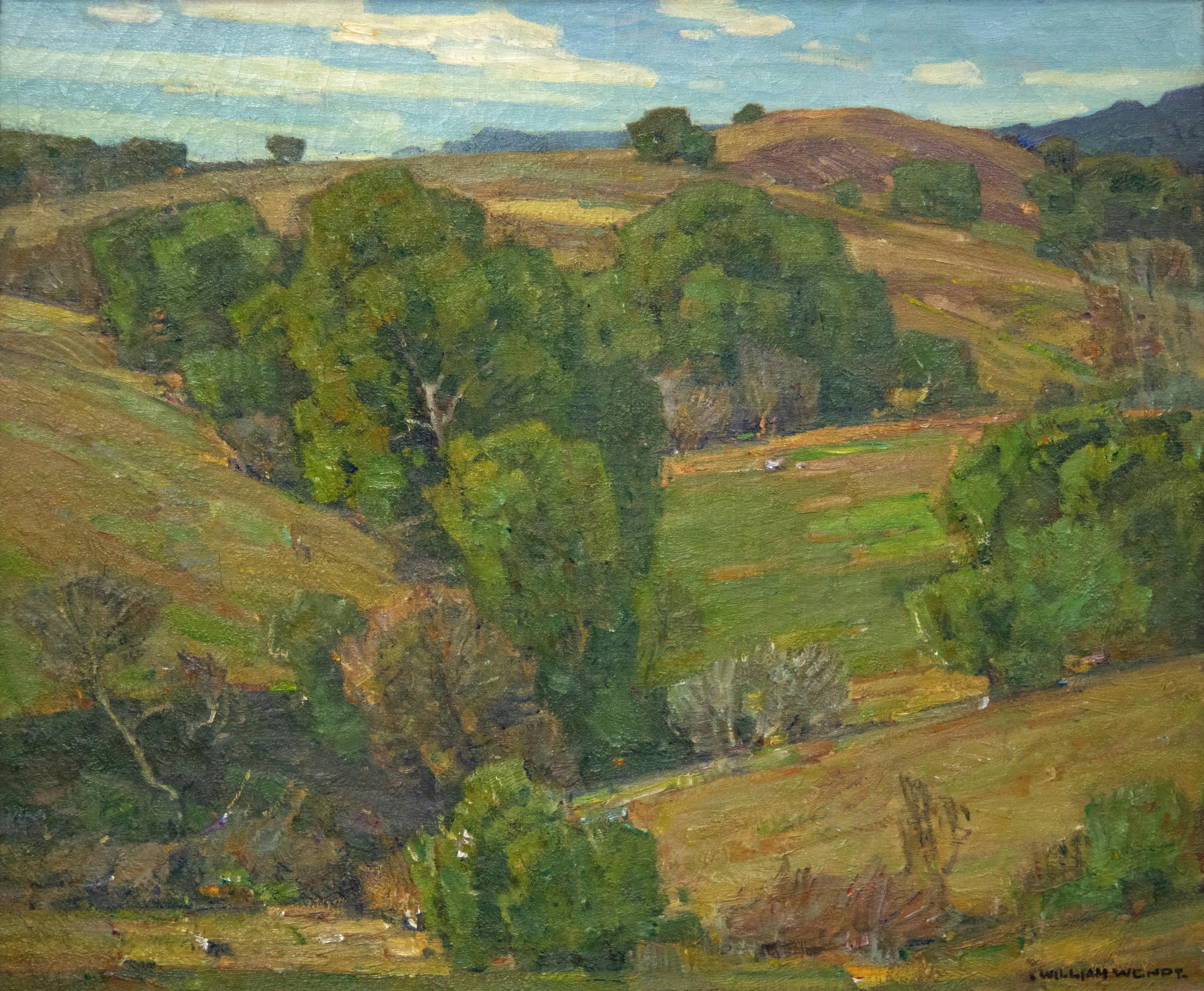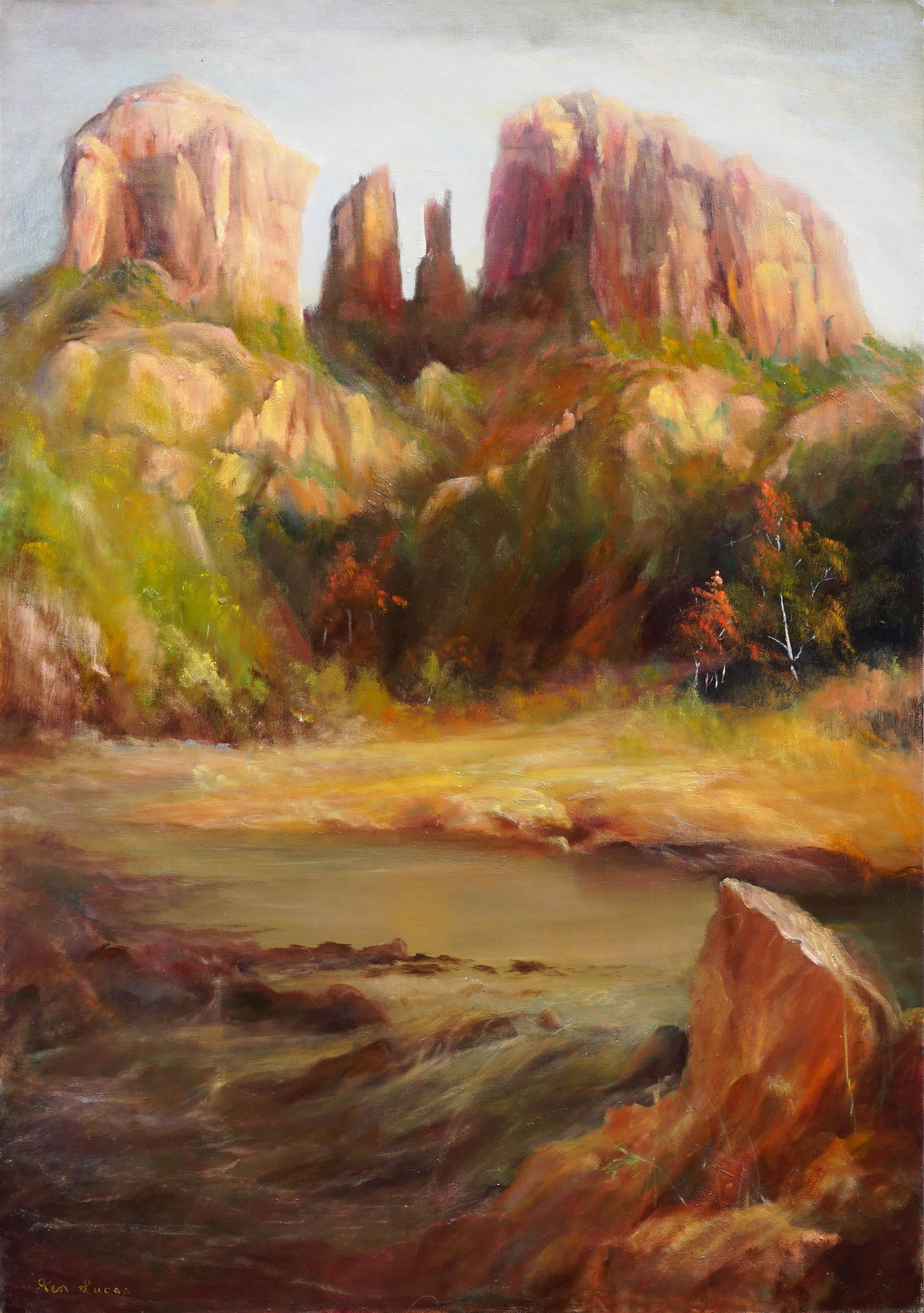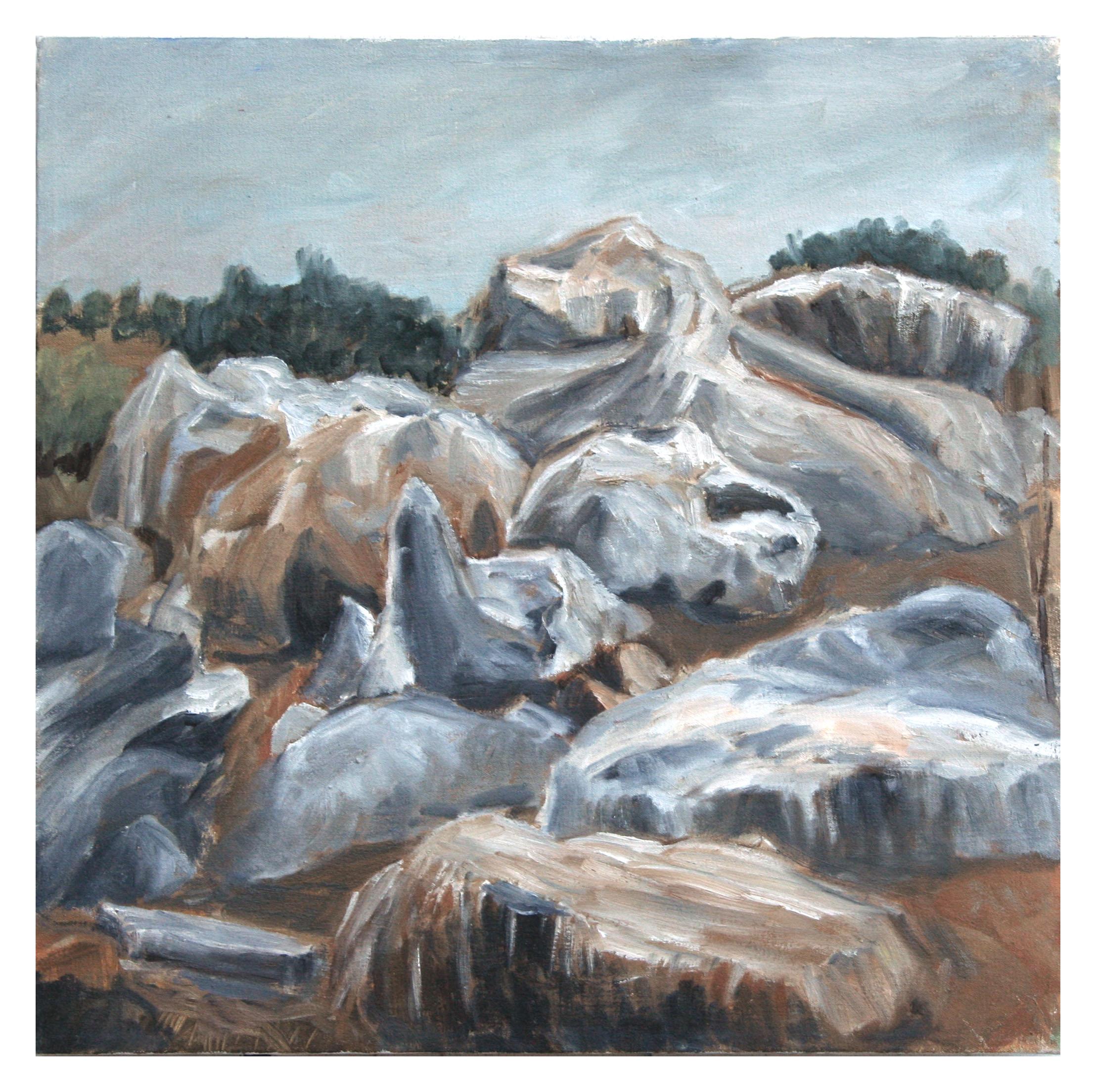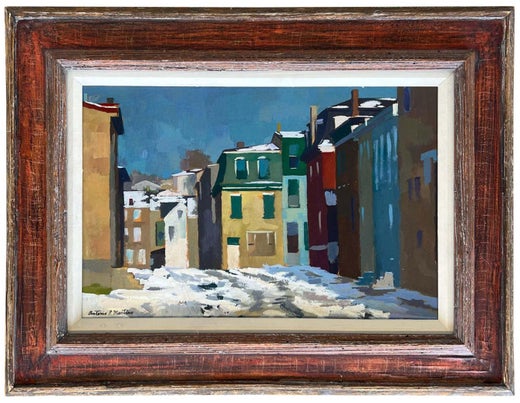Want more images or videos?
Request additional images or videos from the seller
1 of 6
Antonio Pietro Martino"Spring, Oakview"1927
1927
About the Item
Jim’s of Lambertville is proud to offer this artwork by:
Antonio Pietro Martino (1902 - 1988)
Signed and dated lower right.
Complemented by a period frame.
Antonio Martino was one of seven brothers and a sister, all of whom were artists. His father was a mason and stonecutter, and his mother had emigrated from Italy to Philadelphia. He began his studies at the Graphic Sketch Club in Philadelphia. Later he took weekend courses at the Spring Garden Institute and the La France Art Institute while being enrolled full time at the Pennsylvania Museum School of Industrial Art.
In 1941, he and his brother Frank started the Martino Studios, a successful commercial art and design business. All of the Martino brothers participated in the business, which had a staff of twenty artists. Martino’s talents were recognized when he was in his late teens, and by his early twenties, his career had begun to flourish. In 1926, he was the youngest artist to win a medal at the Sesquicentennial Exposition in Philadelphia.
Martino started out painting impressionist landscapes in and around New Hope area. Using a very thick impasto with a heavy impressionist style, his earliest work (1924-1929) was similar to that of Edward Redfield and Walter Schofield. In the latter 1920s and into the 1930x, Martino’s work began to evolve. It still remained impressionist in style, but the brush strokes broadened and the paint application became lighter. He often painted in Gloucester during the summer in the late 1920s and early 1930s. Towards the late 1930s and through the 1940s, his style began to move slightly towards the modernist and his subjects seem focused primarily on the Philadelphia neighborhood of Manayunk. These pictures have a desolate eerie feeling, similarly found in the work of Edward Hopper. Martino was also an accomplished watercolorist.
His work output was high and somewhat uneven. Martino’s earliest work is most commonly admired by collectors and critics, therefore commanding by far the highest values. In 1971, Martino moved to California where he continued to paint modernist coastal scenes and landscapes as well as still life subjects until the end of his life in 1988.
At the National Academy of Design, he won five prizes, including a Gold Medal. The National Academy made him an Associate in 1938 and an Academician in 1942. He also exhibited at the Philadelphia Art Club, the Art Institute of Chicago, the Pennsylvania Academy of the Fine Arts, the Philadelphia Sketch Club, the Corcoran Gallery Biennials, the Carnegie Institute, the National Arts Club, the Salmagundi Club and the Whitney Museum of American Art. During his distinguished career, he earned over eighty awards, had more than ten solo exhibitions and is permanently represented in more than twenty-five public collections.
Sources:
-New Hope for American Art by James M. Alterman
- Creator:Antonio Pietro Martino (1902-1989, American)
- Creation Year:1927
- Dimensions:Height: 48 in (121.92 cm)Width: 58 in (147.32 cm)Depth: 3 in (7.62 cm)
- More Editions & Sizes:Frame Size 49.5" x 59.5" x 2.5"Price: $111,875
- Medium:
- Movement & Style:
- Period:
- Condition:
- Gallery Location:Lambertville, NJ
- Reference Number:
Antonio Pietro Martino
Born in Philadelphia, Antonio P. Martino was the son of italian immigrants and one of eight siblings, all of whom were artists. His father was a mason and stonecutter, and his mother a buttonhole maker. At the age of 13, he attended classes with his brother Giovanni at the Graphic Sketch Club (now Samuel S. Fleisher Art Memorial) in South Philadelphia. Martino then studied with Albert Jean Adolphe at the Philadelphia Museum School of Industrial Art(now the University of the Arts) and took weekend courses at both the Spring Garden Institute and the La France Institute. By the age of 23, Martino had exhibited at the Pennsylvania Academy of Fine Arts in Philadelphia. In 1941, he and his brothers founded Martino Commercial Art Studios, which provided a variety of fine art and promotional design services. All of the Martino brothers participated in the business, which had a staff of twenty artists. While living in the city, Martino and his brothers spent weekend mornings painting in Bucks County, creating landscapes of New Hope and the Delaware River that showed a strong impressionist influence. By 1971, he moved to California to paint seascapes and landscapes, residing there until his death in 1988. The winner of many national awards, Martino was elected as an Associate of the National Academy of Design in 1938 and a National Academician in 1942, one of the highest distinctions awarded to American artists at the time.
About the Seller
5.0
Vetted Seller
These experienced sellers undergo a comprehensive evaluation by our team of in-house experts.
Established in 1997
1stDibs seller since 2014
36 sales on 1stDibs
Typical response time: 4 hours
- ShippingRetrieving quote...Ships From: Lambertville, NJ
- Return PolicyThis item cannot be returned.
More From This SellerView All
- "Spring on Risdon Street, Mt. Holly, NJ"By Hugh CampbellLocated in Lambertville, NJJim’s of Lambertville is proud to offer this artwork. Signed lower right. Complemented by a hand carved and gilt frame. Hugh Campbell (1905-1997) Born December 4, 1905 in Atch...Category
20th Century American Impressionist Landscape Paintings
MaterialsCanvas, Oil
- "Fresh Snow"By Walter Emerson BaumLocated in Lambertville, NJJim’s of Lambertville Fine Art Gallery is proud to present this piece by Walter Emerson Baum (1884 - 1956). Born in Sellersville, Pennsylvania, Walter Baum was one of the only membe...Category
20th Century American Impressionist Landscape Paintings
MaterialsCanvas, Oil
- "Sunlit House, Centre Bridge"By Clarence Raymond JohnsonLocated in Lambertville, NJJim's of Lambertville Fine Art Gallery is proud to present this piece by Clarence Raymond Johnson (1894 - 1981). Clarence Johnson was an important New Hope School Impressionist painter who was active from 1917 until 1935. Born in Ohio, Johnson began his studies at the Columbus Art School. He then came to the Pennsylvania Academy of the Fine Arts where he studied under Daniel Garber, Emil Carlsen, and Cecilia Beaux...Category
1920s American Impressionist Landscape Paintings
MaterialsCanvas, Oil
- "The Canal"By Edward Willis RedfieldLocated in Lambertville, NJJim’s of Lambertville is proud to offer this artwork. Signed lower left. Complemented by a hand carved and gilt frame. Illustrated in "Edward Redfield: Just Values and Fine Seeing" by Constance Kimmerle and the Pennsylvania Academy of the Fine Arts's Exhibition of Paintings by Edward Redfield (April 17 to May 16, 1909) brochure Edward Willis Redfield (1869 - 1965) Edward W. Redfield was born in Bridgeville, Delaware, moving to Philadelphia as a young child. Determined to be an artist from an early age, he studied at the Spring Garden Institute and the Franklin Institute before entering the Pennsylvania Academy from 1887 to 1889, where he studied under Thomas Anshutz, James Kelly, and Thomas Hovenden. Along with his friend and fellow artist, Robert Henri, he traveled abroad in 1889 and studied at the Academie Julian in Paris under William Bouguereau and Tony Robert-Fleury. While in France, Redfield met Elise Deligant, the daughter of an innkeeper, and married in London in 1893. Upon his return to the United States, Redfield and his wife settled in Glenside, Pennsylvania. He remained there until 1898, at which time he moved his family to Center Bridge, a town several miles north of New Hope along the Delaware River. Redfield painted prolifically in the 1890s but it was not until the beginning of the twentieth century that he would develop the bold impressionist style that defined his career. As Redfield’s international reputation spread, many young artists gravitated to New Hope as he was a great inspiration and an iconic role model. Edward Redfield remained in Center Bridge throughout his long life, fathering his six children there. Around 1905 and 1906, Redfield’s style was coming into its own, employing thick vigorous brush strokes tightly woven and layered with a multitude of colors. These large plein-air canvases define the essence of Pennsylvania Impressionism. By 1907, Redfield had perfected his craft and, from this point forward, was creating some of his finest work. Redfield would once again return to France where he painted a small but important body of work between 1907 and 1908. While there, he received an Honorable Mention from the Paris Salon for one of these canvases. In 1910 he was awarded a Gold Medal at the prestigious Buenos Aires Exposition and at the Panama-Pacific Exposition of 1915 in San Francisco, an entire gallery was dedicated for twenty-one of his paintings. Since Redfield painted for Exhibition with the intent to win medals, his best effort often went into his larger paintings. Although he also painted many fine smaller pictures, virtually all of his works were of major award-winning canvas sizes of 38x50 or 50x56 inches. If one were to assign a period of Redfield’s work that was representative of his “best period”, it would have to be from 1907 to 1925. Although he was capable of creating masterpieces though the late 1940s, his style fully matured by 1907 and most work from then through the early twenties was of consistently high quality. In the later 1920s and through the 1930s and 1940s, he was like most other great artists, creating some paintings that were superb examples and others that were of more ordinary quality. Redfield earned an international reputation at a young age, known for accurately recording nature with his canvases and painting virtually all of his work outdoors; Redfield was one of a rare breed. He was regarded as the pioneer of impressionist winter landscape painting in America, having few if any equals. Redfield spent summers in Maine, first at Boothbay Harbor and beginning in the 1920s, on Monhegan Island. There he painted colorful marine and coastal scenes as well as the island’s landscape and fishing shacks. He remained active painting and making Windsor style furniture...Category
Early 1900s American Impressionist Landscape Paintings
MaterialsCanvas, Oil
- "In Port"By Edward Willis RedfieldLocated in Lambertville, NJJim’s of Lambertville is proud to offer this artwork by: Edward Willis Redfield (1869 - 1965) Edward W. Redfield was born in Bridgeville, Delaware, moving to Philadelphia as a young child. Determined to be an artist from an early age, he studied at the Spring Garden Institute and the Franklin Institute before entering the Pennsylvania Academy from 1887 to 1889, where he studied under Thomas Anshutz, James Kelly, and Thomas Hovenden. Along with his friend and fellow artist, Robert Henri, he traveled abroad in 1889 and studied at the Academie Julian in Paris under William Bouguereau and Tony Robert-Fleury. While in France, Redfield met Elise Deligant, the daughter of an innkeeper, and married in London in 1893. Upon his return to the United States, Redfield and his wife settled in Glenside, Pennsylvania. He remained there until 1898, at which time he moved his family to Center Bridge, a town several miles north of New Hope along the Delaware River. Redfield painted prolifically in the 1890s but it was not until the beginning of the twentieth century that he would develop the bold impressionist style that defined his career. As Redfield’s international reputation spread, many young artists gravitated to New Hope as he was a great inspiration and an iconic role model. Edward Redfield remained in Center Bridge throughout his long life, fathering his six children there. Around 1905 and 1906, Redfield’s style was coming into its own, employing thick vigorous brush strokes tightly woven and layered with a multitude of colors. These large plein-air canvases define the essence of Pennsylvania Impressionism. By 1907, Redfield had perfected his craft and, from this point forward, was creating some of his finest work. Redfield would once again return to France where he painted a small but important body of work between 1907 and 1908. While there, he received an Honorable Mention from the Paris Salon for one of these canvases. In 1910 he was awarded a Gold Medal at the prestigious Buenos Aires Exposition and at the Panama-Pacific Exposition of 1915 in San Francisco, an entire gallery was dedicated for twenty-one of his paintings. Since Redfield painted for Exhibition with the intent to win medals, his best effort often went into his larger paintings. Although he also painted many fine smaller pictures, virtually all of his works were of major award-winning canvas sizes of 38x50 or 50x56 inches. If one were to assign a period of Redfield’s work that was representative of his “best period”, it would have to be from 1907 to 1925. Although he was capable of creating masterpieces though the late 1940s, his style fully matured by 1907 and most work from then through the early twenties was of consistently high quality. In the later 1920s and through the 1930s and 1940s, he was like most other great artists, creating some paintings that were superb examples and others that were of more ordinary quality. Redfield earned an international reputation at a young age, known for accurately recording nature with his canvases and painting virtually all of his work outdoors; Redfield was one of a rare breed. He was regarded as the pioneer of impressionist winter landscape painting in America, having few if any equals. Redfield spent summers in Maine, first at Boothbay Harbor and beginning in the 1920s, on Monhegan Island. There he painted colorful marine and coastal scenes as well as the island’s landscape and fishing shacks. He remained active painting and making Windsor style furniture...Category
Early 1900s American Impressionist Landscape Paintings
MaterialsCanvas, Oil
- "The Shepaug"By John Fulton FolinsbeeLocated in Lambertville, NJJim's of Lambertville Fine Art Gallery is proud to present this piece by John Fulton Folinsbee (1892 - 1972). One of the finest painters to embark upon the New Hope Art Colony, John...Category
1910s American Impressionist Landscape Paintings
MaterialsCanvas, Oil
You May Also Like
- Laguna HillsBy William WendtLocated in Palm Desert, CAA painting by William Wendt. "Laguna Hills" is an impressionist landscape, oil on canvas in an earth-tone palette by American artist William Wendt. The artwork is signed in the lower...Category
Early 20th Century American Impressionist Landscape Paintings
MaterialsOil, Canvas
- Picnic ShadeBy Donald S. VogelLocated in Dallas, TXDonald Vogel’s paintings reflect his interest in seeking beauty in life and in sharing pleasure with his viewers. Vogel entreats us to "rejoice and celebrate each new day, knowing it...Category
1980s American Impressionist Figurative Paintings
MaterialsCanvas, Oil
- Jess Panda, SketchBy Ben FenskeLocated in Sag Harbor, NYA contemporary oil painting of a woman stepping out of her small car, a Fiat Panda. Painted from life, shadows are purple and atmospheric. She's parked on bright green grass, in rura...Category
21st Century and Contemporary American Impressionist Landscape Paintings
MaterialsCanvas, Oil
- Sedona Red Rocks, Southwestern Desert LandscapeBy Kenneth LucasLocated in Soquel, CASweeping vertical desert landscape with a calm river in the foreground and the gorgeous formations of Sedona red rocks towering above in the distance, by California artist Ken Lucas ...Category
1990s American Impressionist Landscape Paintings
MaterialsOil, Illustration Board, Canvas
- Rocky Formation LandscapeLocated in Soquel, CADramatic rocky formation landscape in this interesting painting by Trevor Lewis Andrews (American, 20th c.) Signed "Trevor Andrews 2012" on verso. Unframed. Image, 18"H x 18"L. Trev...Category
Early 2000s American Impressionist Landscape Paintings
MaterialsOil, Canvas
- Bucks County Winter LandscapeBy Paul Bernard KingLocated in Milford, NHA wonderful winter village landscape in Bucks County by painted by American artist Paul Bernard King (1867-1947). King was born in Buffalo, New York, and ...Category
Early 20th Century American Impressionist Landscape Paintings
MaterialsCanvas, Oil
Recently Viewed
View AllMore Ways To Browse
Spring Gold
Antique Springs
Studio Twenty Seven
California Impressionist Landscape 1920
1920s Lighter
Martino Italian
James Mason
Antique Oil Lighter
M Martino
Win Lighter
San Francisco Bay Bridge
Vintage Wooden Santa
West Memphis
Yacht Club Art
1990 Luca Luca
1992 Winner
American School 17th Century
Flower Market Impressionist





